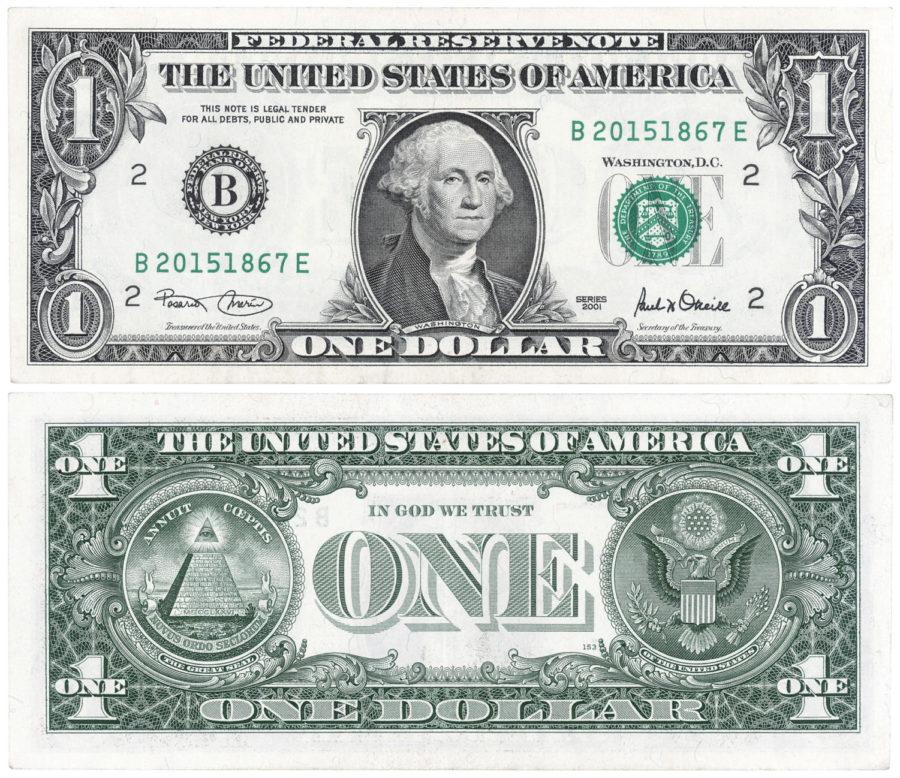Perdios: God + Secularism = The United States
April 16, 2012
One of the more interesting aspects of Tom Short coming to campus is watching the Atheist & Agnostic Society and Short disagree with each other.
Short condemned secular society for making abortion legal and approving homosexuality. The atheists and agnostics criticized Short’s brand of Christianity as being hateful and intolerant. Both sides viewed the other as discriminatory, especially when it came to politics. Everybody else in the crowd ran the spectrum between these two extremes. This exchange continued for all three days of Short’s visit. As I watched all of this, however, money was on my mind, the U.S. dollar bill.
Have you actually looked closely at the dollar bill, both front and back? Take one out while you read this column. What you see there really goes against the idea that this country was founded solely on Christian principles. You will also see evidence that the Founding Fathers had more than simple secularism in mind when they were creating the United States.
Let’s look at the front of the dollar bill. There you see George Washington with that slightly annoyed look on his face. Did you know that historians have had trouble figuring out Washington’s religion because he went to so many different churches? He was most likely a Deist, given his staunch views on the separation of church and state. Washington and many of the other Founding Fathers were also Deists. Generally speaking, Deists believe in a divine creator, who rarely intervenes in human affairs.
Now, let’s look to the back. You probably notice the words “In God We Trust.” It became the official motto of the United States and added to the dollar bill in the late 1950s in response to so-called “godless” communism. This statement does not contradict Deism. Deists believe in God, but without the trappings of religion. The motto certainly doesn’t say “In Jesus We Trust.” In fact, the dollar bill itself also lacks any kind of Christian symbolism.
We especially see this lack of Christian symbolism with both sides of the Great Seal of the United States. The seal first appeared on the dollar bill in 1935, but its origins go back to 1776, was finalized by Congress in 1782 and again in 1789. Some minor alterations to the seal have been made over the years, but its basic design has remained. The image of the eagle on the right (the obverse side of the seal) is a coat of arms used to authenticate passports, flags and so on. The president uses a variant of this seal to authenticate his own documents.
Here we find in this part of the seal ancient Hebrew and Greek symbols. The eagle represents the ancient symbol of Zeus, king of the Greek gods. The eagle itself descends from a cloud of radiant glory with 13 stars arranged to resemble the Star of David, the Seal of King Solomon, representative of transmutation and a host of other meanings. Upon the eagle’s shield are 13 stripes. In one talon, it possesses 13 arrows, representing war. But the head of the eagle looks toward the olive branch in its other talon, which has 13 leaves. In its mouth, it bears the words, as if in proclamation: “E Pluribus Unum” — “out of many, one.”
The number 13 goes beyond simply representing the original colonies, it also represents transformation and rebirth. It also can represent the 12 signs of the zodiac and the sun.
The seal on the left, with the unfinished pyramid, contains even more important symbols relevant to our understanding of the fundamental principles that guided the founding of our nation. Written in Roman numerals at the pyramid’s base is 1776. When you add the numbers together you get 21, which is the number reason. The Founding Fathers played upon this greatly since the Enlightenment led to the Age of Reason.
Above the unfinished pyramid are the Latin words “Annuit Coeptis,” which roughly translates as “Providence approves upon our undertakings.” This was taken from lines written by the Roman poet Vergil from the first century B.C. Below the pyramid are the words “Novus Ordo Seclorum” — “a new secular order.” The overall message is that the Deistic god approves of the founding of the United States as a secular government, separated from religion, unlike the monarchies of Europe at that time.
The Eye of Providence or the Eye of God within the floating apex of the pyramid is arguably the most important of these symbols. The eye can govern with wisdom because it can see all sides of the pyramid, all sides of an issue.
I might be taking this interpretation to an extreme. Yet what I saw during Short’s visit is two groups not understanding, or even refusing to understand, each other. From what I can tell, Short was the more guilty of the two in this regard. But then again, some of his opponents simply dismissed Short as a “religious nut” or heckled him.
Meanwhile, I saw two sides, one secular and one religious, fearful of each other, afraid that one might take the other’s freedoms away. I understand that atheists and agnostics are afraid that religion has encroached too far into secular politics. Short argued that secularism has encroached too far into matters of religion. To view issues that this country faces from either extreme invites ignorance, fear, and anger toward the other side.
The United States was founded with the idea of a balance between church and state, between religion and secularism. All we have to do is look at a dollar bill to be reminded of this.

















